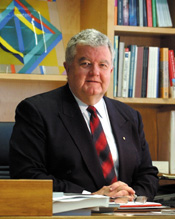
Professor Ian Chubb,
Australia's chief scientist

|
Editorial
- 01 September 2012 |
|
Professor Ian Chubb, |
Do Chief Scientific Advisors Speak Only to the Hand? |
|
Whether he or she is designated the government's Chief Scientific Advisor or Chief Scientist there continues to be debate as to whether or not the position is of any consequence when it comes to affecting the policies of the government of the day.
Colin Macilwain writing in the August 30, 2012 issue of Nature has no illusions:
Two years ago, [the UK government's chief scientific advisor] John Beddington... organized a meeting of 200 civil servants with backgrounds in science or engineering, from different government departments, in an effort to forge better links between them. [But] no one will ever see fit to organize a meeting of the senior officials who, like UK Prime Minister David Cameron, read philosophy, politics and economics at the University of Oxford. They run the country already — and their networking skills are impeccable. [I]n 50 years of trying[to forge better links with science], the underlying dynamic of London's ruling elites hasn't shifted an inch. The public prestige of science is higher than ever but it remains disturbingly removed from the centres of power. And under these circumstances, the scientific community's hope that the scientific adviser will exercise meaningful influence is liable always to be frustrated.
When Robert May, Chief Scientific Adviser to the UK Government from 1995 to 2000 and President of The Royal Society of London, 2000-2005, spoke at the Australian Academy of Science Annual Dinner on May 5, 2011, he was rather more sanguine but with qualification:
The only advice I have about having more influence with government is: "You
have to be lucky". The things that have happened in Britain which are by and
large good, were not necessarily a reflection on the skills of The Royal
Society or others [which] have been just good luck. In the general election
of 1993 one of the Labour Party manifestos — which had been influenced by a
very interesting eminence grise in the Party, Jeremy Bray — was to
create an Office of Science and Technology and to bring in the sort-of
casual Chief Scientist ad hoc one or two days a week... but to make
it a Permanent Secretary — one of the Sir Humphreys — and create a formal
Office of Science and Technology and give it a decent staff. He lost the
election but William Waldegrave of the Conservative Party, a Treasury
Secretary, convinced [Prime Minister] John Major that the manifesto of the
Labour Party ought to be implemented.
That is the origin of how I came to be Chief Scientist [full-time] and I've had two successors. As a Permanent Secretary one meets with all the other senior civil servants on Wednesday mornings. One has direct access to the Prime Minister. Until recently, by some anomaly, the Budget Sub-Committee of Cabinet met with each of the Secretaries of State to discuss their budget and the Chief Scientist to discuss the overall research funding, not just the Research Councils but research everywhere. That particular favour has disappeared but the current Chief Scientist [Sir] John Beddington has in its place the responsibility that, in the current negotiations with the coalition government, any department that seeks to make cuts in its research budget (this is distinct from the overall research budget which is already agreed to be ring-fenced), John Beddington must be involved and if he feels upset about it, then he has access to the Prime Minister and he has an adequate staff to do this, quite a lot of people, good people.
Now that Britain's coalition government has been in office for 2.3 years it's a moot question as to how much luck Professor Beddington has had.
In the United States, where the federal government is clearly divided into executive, legislative and judicial branches, the position of senior advisor to the President on science and technology is within the executive branch and is designated as Assistant to the President for Science and Technology, Director of the White House Office of Science and Technology Policy (OSTP), and Co-Chair of the 21-member President’s Council of Advisors on Science and Technology (PCAST). Through Co-chair, John Holdren, PCAST has direct access to President Obama. It is not responsible to the Congress (legislative branch), although funding for OSTP is subject to determination by Congress. How influential the Assistant to the President for Science and Technology and PCAST are, depends not only on who is the presidential incumbent but also the relationship between the President and Congress.
As Colin Macilwain notes in his Nature article OSTP staff are responsible for "interagency mediation on important but arcane matters such as how to coordinate different satellite systems". However, they also assist PCAST in developing detailed advice through a number of reports which land on the President's desk. How influential they are depends not only on the importance placed on them relative to all the other matters occupying the Chief Executive but also his relationship with Congress.
The stated mission of OSTP?
The mission of the Office of Science and Technology Policy is threefold; first, to provide the President and his senior staff with accurate, relevant, and timely scientific and technical advice on all matters of consequence; second, to ensure that the policies of the Executive Branch are informed by sound science; and third, to ensure that the scientific and technical work of the Executive Branch is properly coordinated so as to provide the greatest benefit to society.
Without any doubt the most influential presidential scientific advisor was the
first one, Vannevar Bush. In the words of Wikipedia: "Bush was a well-known
policymaker and public intellectual during World War II, when he was in
effect the first presidential science advisor. As head of NDRC [National
Defense Research Committee] and OSRD [Office of Scientific Research and
Development], he initiated the Manhattan Project, and ensured that it
received top priority from the highest levels of government. In
Science, The Endless Frontier![]() ,
his 1945 post-war report to the President of the United States*, Bush called for an
expansion of government support for science, and he pressed for the creation
of the National Science Foundation."
,
his 1945 post-war report to the President of the United States*, Bush called for an
expansion of government support for science, and he pressed for the creation
of the National Science Foundation."
In Australia the current chief science advisor to the federal government is the Chief Scientist, Professor Ian Chubb and although his position is fulltime, he meets only rarely with the Prime Minister, and the Office of Chief Scientist has a small staff.
The makeup of the Prime Minister's Science, Engineering and Innovation Council (PMSEIC), which is led by the Chief Scientist, had a makeover in January this year, but there is little indication that either it or the Chief Scientist per se has any significant influence on government policy. For example PMSEIC have not published any reports since December 2010.
Australia's current Prime Minister as well as the Leader of the Opposition have shown no more than cursory interest in science policy, and there is no indication that science policy will be a debated issue during the forthcoming general election due in a little over a year.
______________________________________________
*The report was requested by President Roosevelt on November 17, 1944 and delivered to President Truman on July 5, 1945.
Alex Reisner
The Funneled Web